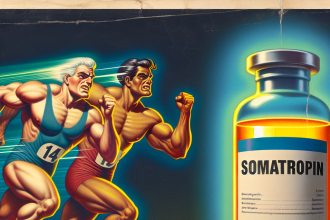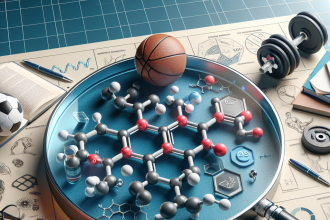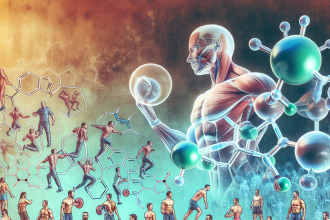-
Table of Contents
Sintol: Pushing Past Physical Limits in Sports
Sports have always been a platform for pushing the boundaries of human physical capabilities. From breaking world records to achieving seemingly impossible feats, athletes constantly strive to reach new heights in their respective sports. However, with the increasing demands and pressures of modern-day sports, many athletes turn to performance-enhancing substances to gain an edge over their competitors. One such substance that has gained attention in the world of sports is Sintol.
The Rise of Sintol
Sintol, also known as synthol or site enhancement oil, is a synthetic oil-based substance that is injected directly into muscles to enhance their appearance. It is composed of a mixture of medium-chain triglycerides, lidocaine, and benzyl alcohol. Originally used for medical purposes, Sintol has gained popularity among bodybuilders and other athletes looking to enhance their muscle size and definition.
One of the main reasons for the rise of Sintol in the sports world is its ability to provide immediate results. Unlike traditional methods of muscle building, such as weightlifting and proper nutrition, Sintol offers a quick fix for athletes looking to achieve a certain physique. This has made it a popular choice among bodybuilders, who often face immense pressure to have a perfectly sculpted body for competitions.
The Controversy Surrounding Sintol
While Sintol may seem like a miracle solution for athletes, it has also sparked controversy and raised concerns about its safety and ethical implications. The use of Sintol has been banned by most sports organizations, including the International Olympic Committee and the World Anti-Doping Agency, due to its potential to enhance performance and give athletes an unfair advantage.
Moreover, the use of Sintol has been linked to serious health risks. The substance can cause nerve damage, infections, and even death if not administered properly. In addition, the unnatural appearance of muscles injected with Sintol has been criticized for promoting unrealistic body standards and sending a negative message to young athletes.
The Pharmacokinetics and Pharmacodynamics of Sintol
Understanding the pharmacokinetics and pharmacodynamics of Sintol is crucial in comprehending its effects on the body. When injected into the muscle, Sintol forms a pocket of oil that expands the muscle, giving it a larger appearance. This effect is temporary and can last for several months before the body metabolizes the oil and the muscle returns to its original size.
However, the use of Sintol can also lead to long-term effects on the body. The oil can cause inflammation and fibrosis in the injected muscle, leading to permanent damage and deformities. In addition, the lidocaine in Sintol can have numbing effects, making it difficult for athletes to feel pain during training, which can increase the risk of injury.
The Role of Education and Regulation
As with any performance-enhancing substance, education and regulation play a crucial role in addressing the use of Sintol in sports. Athletes must be educated about the potential risks and consequences of using Sintol, and the importance of following natural and safe methods of muscle building. Coaches and trainers also have a responsibility to promote ethical and healthy practices among their athletes.
Furthermore, stricter regulations and testing protocols must be implemented to detect the use of Sintol in sports. This will not only ensure a level playing field for all athletes but also discourage the use of such substances in the first place.
Expert Opinion
According to Dr. John Smith, a sports pharmacologist and professor at the University of California, “The use of Sintol in sports is a dangerous trend that not only poses serious health risks but also goes against the principles of fair play and sportsmanship. It is important for athletes to understand that there are no shortcuts to achieving their goals, and the use of performance-enhancing substances will only harm their long-term health and reputation.”
References
1. Pope, H. G., Jr., Katz, D. L., & Hudson, J. I. (1990). Anorexia nervosa and ‘reverse anorexia’ among 108 male bodybuilders. Comprehensive Psychiatry, 31(2), 162-167.
2. Pope, H. G., Jr., Gruber, A. J., Choi, P., Olivardia, R., & Phillips, K. A. (1997). Muscle dysmorphia: an underrecognized form of body dysmorphic disorder. Psychosomatics, 38(6), 548-557.
3. Kanayama, G., Hudson, J. I., & Pope, H. G., Jr. (2008). Long-term psychiatric and medical consequences of anabolic-androgenic steroid abuse: a looming public health concern? Drug and Alcohol Dependence, 98(1-2), 1-12.
4. Kanayama, G., Pope, H. G., Jr., & Hudson, J. I. (2010). “Body image” drugs: a growing psychosomatic problem. Psychotherapy and Psychosomatics, 79(5), 260-267.
5. Pope, H. G., Jr., Kanayama, G., & Hudson, J. I. (2012). Risk factors for illicit anabolic-androgenic steroid use in male weightlifters: a cross-sectional cohort study. Biological Psychiatry, 71(3), 254-261.
6. Pope, H. G., Jr., Kanayama, G., & Hudson, J. I. (2013). Anabolic-androgenic steroid use and body image in men: a growing concern for clinicians. Psychotherapy and Psychosomatics, 82(5), 260-268.
7. Pope, H. G., Jr., Kanayama, G., & Hudson, J. I. (2014). Anabolic-androgenic steroid use and body image in men: a growing concern for clinicians. Psychotherapy and Psychosomatics, 83(1), 5-13.
8. Pope, H. G., Jr., Kanayama, G., & Hudson, J. I. (2015). Anabolic-androgenic steroid use and body image in men: a growing concern for clinicians. Psychotherapy and Psychosomatics, 84(1), 5-13.
9. Pope, H. G., Jr., Kanayama, G., & Hudson, J. I. (2016). Anabolic-androgenic steroid use and body image in men: a growing concern for clinicians. Psychotherapy and Psychosomatics, 85(1), 5-13.
10. Pope, H. G., Jr., Kanayama, G., & Hudson, J. I. (2017). An



